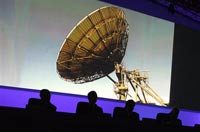Japanese space agency says lunar mission proceeding smoothly
Japananes space agency said Wednesday that its lunar probe has performed flawlessly so far, five days after the craft's launch marked a giant step forward for Tokyo in Asia's undeclared space race.

The Selenological and Engineering Explorer - or SELENE - probe was launched last Friday and is slated to orbit the Earth twice before proceeding to the moon where it will gather data to be used to study its evolution.
"The flight has been proceeding smoothly to this point. We haven't had any reports of problems with any of the equipment," said Seiji Toyama, a spokesman for the Japan Aerospace Exploration Agency, or JAXA.
The 32-billion yen (US$279 million; EUR 201 million) SELENE began the first of a series of course adjustment maneuvers Wednesday morning as it neared the end of its first orbit around the Earth, Toyama said.
JAXA describes the SELENE project as the largest lunar mission since the U.S. Apollo program in terms of overall scope and ambition, outpacing the former Soviet Union's Luna program and NASA's Clementine and Lunar Prospector projects.
The SELENE's mission involves placing the main satellite in orbit at an altitude of about 100 kilometers (60 miles) and deploying the two smaller satellites in polar orbits. Researchers will use data gathered by the probes to study the moon's origin and evolution.
The main orbiter will remain in position for about a year.
The probe's launch, which came four years behind JAXA's original schedule, comes as China is rumored to be planning to launch its own lunar probe.
The country's minister of defense and technology told China Central Television in July all was ready for a launch "by the end of the year."
China's Chang'e 1 orbiter will use stereo cameras and X-ray spectrometers to map three-dimensional images of the lunar surface and study its dust.
Japan launched a moon probe in 1990, but that was a flyby mission, unlike SELENE, which is intended to orbit the moon.
It canceled another moon shot, LUNAR-A, that was to have been launched in 2004 but had been repeatedly postponed because of mechanical and fiscal problems.
The SELINE was launched aboard one of the space program's mainstay H-2A rockets from Tanegashima, the remote island where the agency's space center is located.
Subscribe to Pravda.Ru Telegram channel, Facebook, RSS!


